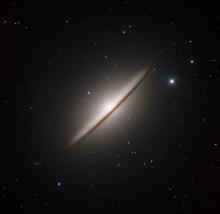X-rays from a disk of hot gas around a supermassive black hole in NGC 1275 push back at gas that's falling into the black hole, creating sound waves. Although the waves are far below the range of human hearing, astronomers recently pitched them up 57 to 58 octaves to make them audible. The black hole is about 800 million times the mass of the Sun. NGC 1275 is at the center of the Perseus Cluster, one of the largest galaxy clusters yet seen. Hot gas in the cluster falls into NGC 1275, where it's funneled toward a disk of superhot gas around the black hole. This composite image includes visible light captured by the Sloan Sky Survey, X-rays (blue) from Chandra X-Ray Observatory, and radio waves (pink) from the Very Large Array radio telescope in New Mexico. [Marie-Lou Gendron-Marsolais (Université de Montréal), Julie Hlavacek-Larrondo (Université de Montréal), Maxime Pivin Lapointe]
You are here
Moaning Black Hole
That’s the moan of a supermassive black hole. The black hole inhabits the heart of NGC 1275, a giant galaxy at the heart of one of the largest galaxy clusters in the universe. The interplay of the material around the black hole creates sound waves that ripple through giant clouds of gas. Scientists pitched the sound waves into the range of human hearing.
NGC 1275 belongs to the Perseus Cluster — a collection of thousands of galaxies. They’re bound to each other by their mutual gravitational pull. And they’re embedded in a vast cloud of gas that’s heated to millions of degrees.
Some of that gas is falling into NGC 1275. It feeds the black hole, which is about 800 million times the mass of the Sun. Some of the gas forms a swirling disk around the black hole. The disk shines brilliantly, especially in X-rays. That energy pushes some of the gas outward. The gas ripples through the surrounding clouds, producing sound waves.
The waves are far, far below human hearing. So astronomers pitched them up by 57 or 58 octaves — allowing us to “hear” the moaning of a supermassive black hole.
NGC 1275 is in Perseus. The constellation is low in the northeast around midnight, and high in the east at dawn. But you need a telescope to see this busy galaxy.
Script by Damond Benningfield
Get Premium Audio
Listen to today's episode of StarDate on the web the same day it airs in high-quality streaming audio without any extra ads or announcements. Choose a $8 one-month pass, or listen every day for a year for just $30.







